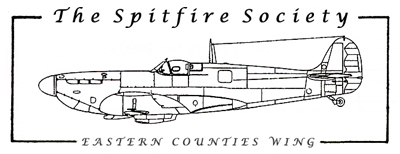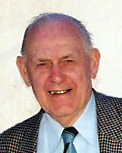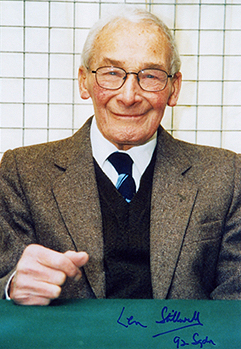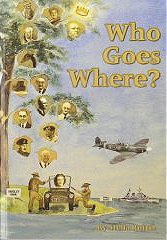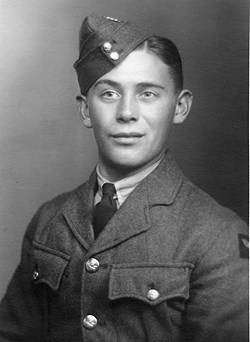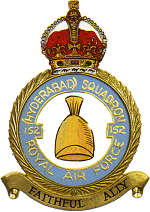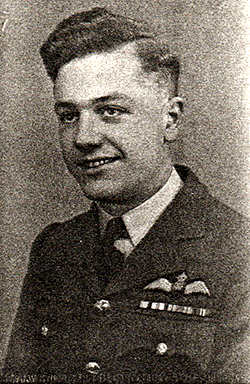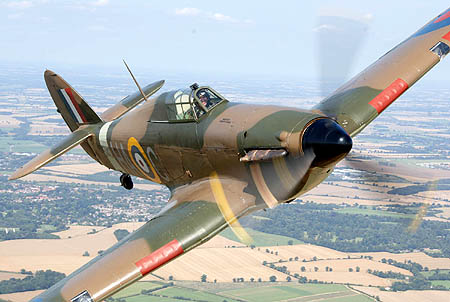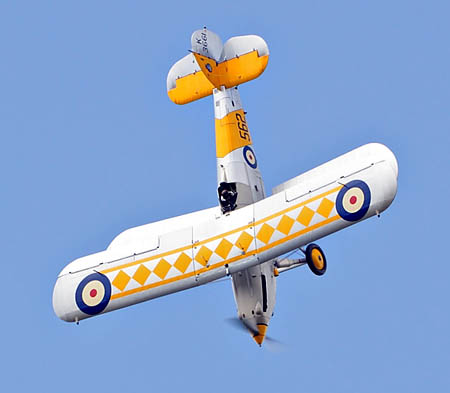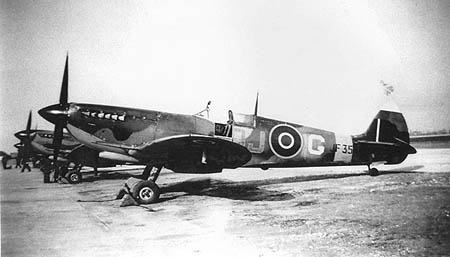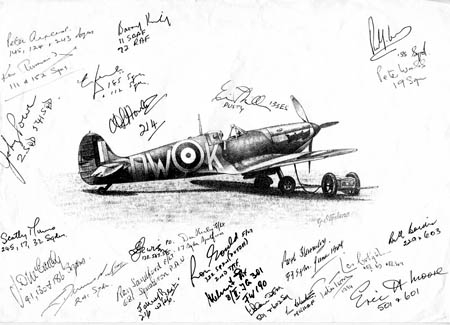 Home Page
Pat Butler
|
INDEX
A Tale of Two Tails - Ray Johnson
Aviation Training Part 3 - Ken Bradley
A Ferry Story - Geoff Bates
Commemoration of The Battle of Britain
---------- At this time it
is customary for me to reflect on the year that has just gone
by, as well as looking forward to the New Year. The last year
has been a busy and interesting one for our Wing. Our attendance
at eight air shows proved very successful. Let me take the time
to thank all members who gave their time so freely and
willingly. Your efforts are very much appreciated and greatly
valued, not only on the financial side but also for the
fellowship and pleasant company which is so important. We earnestly
look forward to 2010 and to be at Duxford for the seven air
shows. We do so need more volunteer helpers; do please give it a
thought. I would like to
end on a personal note and extend my special thanks to my
colleagues on the Eastern Wing Committee. I thank you all.
David
----------------------------------- Welcome to Form 700 We are pleased
to start this edition of the Form 700 with the good news that
our dear friend the late Leonard Stillwell has left what is
thought to be a substantial bequest to this wing of the Spitfire
Society in his will. I understand that a similar amount has been
left to the main body of the Spitfire Society.
For those people
who may not know of him, Len, a former Spitfire pilot with 92
Sqn was one of the most dedicated members that this Society
could ask for, working, for a great many years amongst other
things, as a member of our Regional Committee and as a Sales
Stand Helper. Despite a
serious leg injury inflicted by ground-fire whilst on a patrol
over Italy in 1944, which caused him great discomfort right up
until his death, Len worked astonishingly hard for us whilst at
the same time, in recent years, caring for his wife Dot, herself
a former wartime WAAF in Bomber Command. These were two of our
most respected and loved regional members, and our current
Chairman Sqn Ldr Leonard Dickson, who has taken a keen interest
in Len’s bequest, has said that he would be the first to
recognise that we set a standard in Eastern that enthused Len to
leave this sum to us; by the time this number goes to print
Committee Members from Eastern Wing, who have of course the
advantage of many years experience in handling charity funds,
hope to have met with Leonard to brief him on our strategy for
utilising the bequest – we will of course keep you informed. The air show
season for 2009 went well with good takings at the sales tent
despite numbers being down on last year and frequently unkind
weather. Our Chairman David Williams managed once again to
secure a place for us at all of the Duxford shows so well done
and thank you David, and thanks also to our amazing group of
helpers who work so hard for us, especially Committee Member
Steve Beale who year in year out brings the marquee and sets it
up, and without whom we would be lost.
A notable occasion last year was
the Spitfire Day at Duxford which saw a number of well known
aircraft displaying including ML407 piloted by Richard Grace and
BM597 flown, as ever, by our Patron Flt Lt Charlie Brown. Also
flying was Mk.IX, I.A.C.161, which in its former life as PV202
was flown during the war by one of our much missed members, the
late Bert Harman of 33 Sqn. As well as some great flying there
were a number of other activities including a talk by E.W.
member Sqn Ldr Ian Blair DFM. It was a long day for our
helpers particularly those selling raffle tickets so Thank You
to them for their invaluable help at this and all our other air
shows. Many readers
will be aware that Eastern Wing Member Howard Cook was seriously
hurt in an accident in Canada involving a tiger moth and the
ground back in August, when his engine failed shortly after
takeoff. The good news is that Howard has gone on to make a
remarkable comeback and is well on his way to recovery on what
has been a painful but determined journey. He has had great
support from his friends and colleagues both here and in Canada,
and I know he would want me to make a special mention for his
wife Peta who has been totally supportive. Keep up the good work
Howard, we look forward to seeing you back in the air very soon.
This edition of
the Form 700 Newsletter includes the final part of Ken Bradleys’
story (parts 1 & 2 may be found in issues 52 & 53 of this
journal) where he gets to fly the Spitfire MKs V & VIII, a
remarkable item which continues the recent theme of Spitfire
tail-flights sent in by Lincolnshire member Ray Johnson, former
armourer with 152 Sqn and the start of a new serialisation about
the fascinating and varied work of the wartime Ferry Pilot
contributed by Geoff Bates. As noted in the last issue of
‘Spitfire’ it was hoped that the Autumn edition of the Form 700
Newsletter would be going out to the whole Wing Membership but I
gather that this did not happen due to the ongoing work
co-ordinating numbers of members etc. However if anyone would
like to read the Newsletter a version with extra photographs may
be found on our excellent Eastern Wing Website
www.spitfiresocietyeastern.org.uk - the site
also features back issues of the Form 700 as well as lots of
other splendid features including interviews, picture gallery,
merchandise and much more. Back in
November, I was pleased to receive a phone call from former
Central Region Chair, Stella Rutter, who rang to compliment us
on our little Newsletter and to put forward one or two
suggestions for future issues, which we have adopted. As regular
visitors to our website will know, earlier in the year Stella
had been attending book signings for her splendid publication
‘Who Goes Where?’ which tells of her remarkable wartime career
which included high-level work at Supermarine and special duties
detailed to her by Montgomery himself! A very fine book which
comes highly recommended.
In other news,
wreaths were again laid last year on behalf of the Eastern Wing
at the North Weald Airfield Memorial and the Cross of Sacrifice,
St. Andrews Church N.W. on Battle of Britain Day and Remembrance
Sunday. The wreaths were laid by David Williams and Sqn Ldr Ian
Blair DFM. The Southampton
Roundel Group had a busy time last year with 2 events held at
the internationally renowned Banister Park Bowling Club in
Eastleigh (group coordinator and esteemed Society photographer,
Mike Bayliss, is quick to point out that this is a sedate bowls
and jack bowling club and not the noisy ten pin variety!) The
first, a July lunch at the club with aviation legend, Peter
Twiss and his wife Jane as guests of honour, and the second a
Christmas luncheon. Mike tells me that both were well attended,
congenial affairs with excellent service provided by the
restaurant staff, and that for the summer lunch, Alyson Farr
prepared a special cake to mark the occasion. Future planned
events include a visit to the impressive National Air Traffic
Services control centre at Swanwick in Hampshire. The
Southampton Roundel meets on the second Saturday of each month.
Further details may be obtained from Mike Bayliss on 02380
844877. The Eastern Wing
Helpers and Committee Christmas lunch was once again a splendid
occasion and we were, as ever, well looked after by our friends
at The Squadron. We were pleased to have with us as ever two of
our most loyal and hardworking supporters Audrey Morgan and Ian
Blair, as well as Ron Scott who when not supporting Eastern Wing
is busy looking after the Blenheim Society. Our guest of honour
this year was Wg Cdr Peter Ayerst DFC who spent time chatting
with members and stood up to say some very kind words after
lunch. Peter is a great ambassador for the Spitfire Society who,
as well as representing the finest values of all that we stand
for, is always so kind and generous with his time – Thank You
Peter, it was a pleasure and an honour having you with us. For this year we
are already looking ahead to the new air show season, so if
you’d like to help out do come forward, your support will be
greatly appreciated. Hopefully we will be able to organise some
visits, though events organised for last year were sadly not
well attended. There is currently a vacancy on our committee for
an Events Organiser, so again if you think you can help, get in
touch. As ever your Committee here at Eastern Wing is
enthusiastic and optimistic for the year ahead so best wishes to
all our members for a happy and fruitful 2010. If Roundels
Clubs or Wing Members have news or information which they would
like to see in the announcements pages of the Newsletter please
contact the Editor, details on back page. Peter Wesson -----------------------------------
Ray Johnson
The stories
that we have published recently about incidents of ground crew
unexpectedly riding on the tails of Spitfires has prompted
another response on the subject, this one from Ray Johnson in
Lincolnshire; many thanks Ray. As well as
being an active and enthusiastic member of our society Ray is
also closely associated with the 152 Squadron website,
www.152hyderabad.co.uk, who have kindly sent
us some photographs. It’s a splendid site, well worth a visit
and where you will find pictures of Ray in his Spitfire Society
tie as well as some photos of our good friend, the late Ken
Plumridge, whom Ray mentions in the item below. I joined 152
Squadron (Spitfires) at Acklington in January 1940 as an
armourer AC1 and stayed with the Squadron throughout the rest of
WWII reaching Sergeant in September 1944 in Burma. At Acklington,
No. 72 Squadron C.O. Sqn Ldr Ronnie Lees joined us. This was a
very bad winter weather-wise, heavy snow and blizzards. 152 had
become operational on Spit’s in January but we were forced to
continue op’s on our remaining Gladiators until about March. But
the grass airfield was still very tacky and ground crews sat on
the tails whilst taxiing, banging the fuselage with their hands
to signify them leaving. One day at this time a 72 Sqn Spit’
took off still with a ground crewman on the tail, did a circuit
and completed a good landing with no injury to the passenger.
This incident reached the national newspapers, but not through
the official channels, much to the stationmaster’s anger. No. 152 soon
went overseas in October 1942 to North Africa, ‘Operation Torch’
and was operating from Souk-El-Arba airstrip in Tunisia along
with 72 and 111 Sqns Ronnie Lees was now commanding the Wing. 72
and 152 were airborne on an operation and I was one of two or
three left at dispersal whilst the rest went for a meal and a
wash and brush-up. A Spitfire took off (conditions were very
bad, like Acklington 1940), and I saw the airborne Spit’
behaving very erratically. I realised that someone was on the
tail and rang Aerodrome Control from 152’s tent and told them. I
was told to hang on and he presumably looked outside; he came
back and said “Bloody Hell, you’re right!” or words to that
effect. The Spitfire did a wheels-up landing and the passenger
broke an ankle. In November
1944, by which time 152 was the first squadron to re-enter
Burma, a replacement pilot joined us, Ken Plumridge who had been
with 111 at Souk-El-Arba. Many years after the war Ken confirmed
to me that the pilot in North Africa with the tail-passenger was
Tommy Tinsey, and much later I discovered the passengers name
was L.A.C. Donaghue. I suppose
witnessing this twice could be something of a record!
Colin Cregg has contacted us with news of a site he has
set up in honour of his father, Eric Clegg, who flew Spitfires
with 152 Squadron in Burma:
http://homepage.ntlworld.com/colin.clegg1 'This web site tells my
father's story of his Royal Air Force service during World War
11 He was one of many unsung heros who volunteered to fight for
his country to defend the rights of everyone to live in a free
and democratic society. I have in my possession my
father’s flying log book and photographs which document his R.A.F. service from Pilot training in America through to active
service flying Spitfires with 152 Hyderabad (F) Squadron in
Burma. I have used these documents as a starting point to tell
his story. Through my research I have
been able to reunite my father with old comrades from 152
squadron with which he served in Burma 1944-1945.' Thank you Colin for
getting in touch. ----------------------------------- Part III Ken Bradley If you have not read the first 2 parts, you
can find them here:
No. 73: O.T.U. Fayid
No. 3: R.F.U. Poona 28
February 1945 Following our arrival at
O.T.U Fayid, and, settled in new quarters, it was not too long
to wait before being allowed to look at the aircraft that, for
the next three months, we were going to fly - "the MK V
Spitfire" - and, for the first time, alone in the cockpit with
only the pilots notes for company, the thought was a bit
daunting! However, prior
to that first flight, we had to practise a few cross-wind
landings in a Havard, with an instructor. With the narrow
undercarriage on the Spitfire, it was a necessary capability, in
view of the single runway at Fayid. Having completed
all the checks successfully, and, two weeks after arriving at
the airfield, the great day for that initial flight came along! The difference
between the two aircraft was amazing and having to adjust the
handling of the Spitfire after take-off, changing hands to
operate the hydraulic lever on the under-carriage, was not easy.
(I felt sorry for the left-handed pilots with this problem)!
After a time, it became second nature. Nevertheless, it proved a
bit tricky for the first few exercises. For the
following three months, and on most days, it was quite a hectic
programme to fulfil. With increasing confidence each time, we
carried out the task that was set. Air to air, formation flying,
(with the result shown on film,) and live firing on the ranges
with machine gun and cannon. One exercise
involved an oxygen climb to 30,000 ft or so, to feel the effect
on the controls at high altitude, making sure to turn on the
oxygen supply before take-off. On rest days, we
went swimming at the "Blue Lagoon" lido on the great lake nearby
at Ismalia. In a recent
newsletter, an article described the removal of the Spitfires
ferrying them away from 73 O.T.U. I noticed that, six of those
listed appear in my Logbook, bringing back a few memories of a
beautiful and, most enjoyable time at Fayid with the "MK V". The next phase
included a stay in Cairo and a transfer to India via Karachi,
then on to No. 3 R.F.U. Poona, to include a jungle surviving
course at Bhopal, and a change to the more powerful Spitfire MK
VIII for high dive bombing and straffing exercises. Thankfully,
the instruments were the same as the MK V, although a more
powerful engine size! (Merlin 66 series). However, the
ending of the Japanese war came during the course, and VJ Day
arrived, thereby, we were unable to join a squadron of the kind
we had trained for. This came as a complete surprise, as was the
visit of a high ranking Naval Officer, none other than Lord
Louis Mountbatten whilst serving in the Burma campaign in
S.E.A.C. prior to the ending of the war in that region. Our thoughts of
returning to the UK were swiftly dashed, when the next posting
was to the same area! Firstly, a trip to a transit camp in
Calcutta, where we were able to sample the delights of the
famous Indian Restaurant - namely 'Firpos' and their delicious
ice-cream. We managed, at least, a couple of visits there! Then
on to Rangoon to join Transport Command and, in my case, 194
Squadron at Mingaladon as second pilot on Dakotas, the most
famous work horse for transport throughout the war in the Far
East area, and for some considerable time afterward. However, barely
a month or two at Rangoon with 194 Sqn, a few of us were posted
to Singapore to join up, again as co-pilot, to 31 Sqn S.E.A.C
who were short of aircrew needed to maintain strength prior to
the entire move to Batavia (Jakarta) in Indonesia. This was in
support of the disagreement over control of the country, between
the Dutch and the Indonesian governments, known as the Dutch
East Indies (until the occupation by the Japanese). The carrying
capacity of the Dakota was fantastic and, once the two Pratt &
Whitney engines roared into life, rarely let you down. Toward
the end of the operation, we were bringing out from the interior
Japanese soldiers for repatriation back to their homeland, and
they looked as though they were only too pleased it was all
over. We never had any cause for concern, especially as we had
on the aircraft a Ghurka army soldier every time we made the
trip back and forth to the assembly point at Bandoeng Airport. Having completed
my time with 31 Sqn and, along with a few others, I flew to
Singapore to join the P&O liner Ortranto to embark for the
journey back to the UK. From the warm weather to the cold winter
followed by disembarkation at Southampton in mid-December 1946. Following a
spell of home leave, I received notice to proceed to Blackpool
for demobilisation back to civilian life. Two years of
this and I missed flying. Therefore, I decided to re-join the VR
and found myself at Cambridge, with other part-time volunteers,
flying from Marshalls airfield with 22 RFS on weekend and annual
training flights, around the beautiful Cambridgeshire
countryside flying Tiger Moth and Chipmunk aircraft - most
enjoyable! In fact, looking
back, I enjoyed the experience for the whole time during my
R.A.F. service, in particular, the time I had with the
remarkable Spitfire. ----------------------------------- Geoff Bates
On completion of my pilots course in Southern
Rhodesia (now Zimbabwe), a number of us were flown in a Lockheed
Lodestar to Cairo where we expected to be posted to fighter
squadrons.
After ten days in a huge tented transit camp
outside Cairo we were transferred to a transit camp in Gaza in
Palestine where a week later we were moved to an aircrew transit
in Jerusalem where we discovered how much religion was
commercialised. For example, for just under a pound one could
buy a piece of the actual cross on which Christ was crucified!
You knew it was genuine because a certificate was given with it
saying so!
After lunch one day we were told that we had
been posted to Transport Command and were going to Bilbeis near
Ismalia in Egypt to convert on to fighters to become ferry
pilots. Most of us were disappointed at the news as we saw the
joining of a squadron as the ultimate step after training. Three
of us were granted an interview with the CO to request that we
be posted to a squadron. The CO, having given each of us the
opportunity to have our say, said:
1. A ferry pilot’s job is as vital to the
war effort as any squadron pilot as squadrons rely on deliveries
made by ferry crews to ensure their strength is maintained and
that aircraft requiring major overhauls can be flown to
maintenance units.
2. You will probably have the opportunity
which normally is not available to squadron pilots of ferrying
many different types of aircraft and that experience will no
doubt make you very proficient pilots.
3. You will find that the world of
ferrying produces its own excitement, pleasures and
satisfactions.
4. Finally you have all been in the Royal
Air Force long enough to know that you obey orders, so off you
go and be proud of the fact that you are doing a very worthwhile
job.
So off to Bilbeis where we converted on to
Spitfires, Hurricanes and Kittyhawks followed by a posting to
one of the four aircraft delivery units (ADU’s). I was posted to
No 1 ADU which was housed in blocks of flats in Heliopolis on
the outskirts of Cairo. No 1 Aircraft
Delivery Unit
The job of single engine pilots at No 1 ADU
based at Heliopolis was to ferry Hurricanes from Takoradi on the
Gold Coast (now Ghana) to Karachi in India (now Pakistan) where
another ADU would fly them to squadrons operating against the
Japanese.
We used to fly in convoys of six where the
leader also had to act as navigator. However, when flying over
the sea or hazardous land masses e.g. rainforest or a large
expanse of dessert, we were led by a twin engined aircraft so
that if a pilot had to ditch or force land the leading aircraft
could send out a mayday (SOS) to facilitate the recovery of the
pilot. Because of the nature of the route from Takoradi to Cairo
single engined convoys were always led by twin engined aircraft.
I had only been at No 1 a couple of days when
my name appeared on orders to go to Takoradi. We were flown to
Accra West Africa in Ensigns of BOAC. There we had to change on
to a Lockheed Hudson of the Belgian Airlines (Sabena) to take us
on to Takoradi. One thing we didn’t like about being ferry
pilots was the amount of passenger flying we had to do to pick
up our aircraft or return to base after having made our
delivery. Sometimes we had to fly with pretty ropey pilots to
get back to base. I logged 469.35 hours as a passenger. En route
to Takoradi we stopped at Khartoum. I wasn’t feeling too well so
decided to go to sick bay to get something to settle my stomach.
I was discharged from the sick bay three weeks later having had
yellow jaundice! The powers that be decided that I must have a
weeks sick leave when all I wanted to do was to get airborne
again. I was sent to Alexandria.
To digress for a moment, when first called up
we were based in luxury flats overlooking Regents Park. As a
treat we were all marched to the open air theatre in the park to
be the audience in a film starring Vera Lynn called ‘Till We
Meet Again’. At times the cameras would sweep across the
audience. It so happened that Vera Lynn’s film was showing in
Alexandria so naturally I went to see it. Imagine my surprise
when the camera panned along the row in which I was sitting. I
saw my Corporal; I wasn’t sitting very far from him so any
second now I would see myself. Just then, someone behind me
tapped me on the shoulder. I turned round to hear a young lad
say “Me got nice sister, very cheap!” I told him to clear off
(or perhaps stronger words), and reverted my gaze to the screen,
by which time another part of the film was being shown!
To
be continued… ----------------------------------- Despite being a
hot and humid day with the occasional threat of rain, the
weather stayed dry and allowed for some excellent flying. The first
Spitfire to take to the sky was ML407, piloted by Richard Grace,
who gave a thrilling display of this much-loved aeroplane. I
understand that this was Richard’s first public appearance
displaying the Grace Spitfire and this fine performance was a
great credit to his mother, Spitfire legend Carolyn Grace, and
to his father Nick Grace, the man who restored ML407 to flying
condition and who is, of course, sadly no longer with us. We
wish Richard a long and happy future flying this wonderful and
iconic aircraft. Next up were Mk
Vb BM597, piloted by Spitfire Society Patron Flt Lt Charlie
Brown, and Mk IX’s PV202 and MH434, soaring above first in
three-vic formation followed by spectacular tail-chasing, the
precision flying a marvel to behold. Last to appear was one of
the formidable Griffon-engined Mk XIX’s of the Battle of Britain
Memorial flight. This powerful aircraft gave a spirited display,
the sunlight glinting on the wings as it wheeled and turned
showing to perfection all angles of its graceful airframe. The four
Spitfires spent the rest of the day parked near to the
spectators’ barrier which afforded splendid opportunities for
the public to take photographs. Also stationed nearby was the
awesome B.17 bomber “Sally B”, and coming and going throughout
the day giving pleasure-flights were the delightful Tiger Moths
and DH Dragon Rapides based at Duxford. A number of
distinguished visitors came and spent time at the Spitfire
Society sales-stand including Flt.Lt. Charlie Brown, our good
friend Peter Ayerst who is, of course, a veteran of the Battle
of France and the Battle of Britain, and Sqn Ldr Ian Blair DFM
who gave two talks in the Main Hanger lecture hall that day. Ian
is a staunch supporter of our Society and a regular contributor
to this magazine. There was a
steady stream of customers to our stand and we did very well in
raising significant funds for the Spitfire Society. The raffle
prize was a fine Robert Taylor print signed by a number of
famous Spitfire pilots. The raffle was drawn by young Jemima
Wesson who also spent time selling raffle tickets. As always our
volunteers worked extremely hard and special mention should go
to Doug Bland who spent several hours standing outside under the
sun selling raffle tickets; thanks to Doug and to all our
helpers. P.W. ----------------------------------- Irene Pascall In August 2009
we lost a loyal and dedicated friend when Irene Pascall passed
away. Irene, or Renee
as we knew her, was one of our regular helpers on the Eastern
Wing sales stand and, since the early days of Eastern Region,
could be found along with her husband Norman working hard at air
shows come rain or shine, from morning until evening, raising
the funds upon which our Society depends; one may only guess at
how many thousands of pounds she helped generate for us. She had a
wonderful way of engaging the public with her friendly, kind and
cheery disposition and was a truly outstanding representative of
all that is good about the Spitfire Society. Renee was also a
marvellous supporter of our visits and events and was active in
all aspects of running our region. She was greatly loved and we
will miss her very much. When we set up our stand on those
bright, crisp, sunny mornings at Duxford the warmth of her
memory will always be with us. We send our
heartfelt condolences and kindest thoughts to Norman and family. P.W. Last year the
son of R.J. Mitchell, Dr. Gordon Mitchell died. Much has already
been written about this remarkable man who campaigned for
official recognition of his father, the man who of course headed
the design team responsible for the most famous combat aircraft
of all time. Paul Plummer presents this personal tribute. Dr Gordon Mitchell We lost one of
our greatest Spitfire icons in July 2009. His departing brings
to an end the hands-on close up Spitfire Connection. As the son of
one of the greatest designers of aircraft he could have been
overshadowed, but he took a different line in his career and was
extremely successful. I meet him in The Hall of Aviation one wet
cold night, when he unveiled a statue to his father. Among this
crowd was Jeffery Quill, Alex Henshaw and many other people of
note. We had an interesting talk and I found him most
fascinating. I remember he felt this country had not recognized
his father as it should have and spent many hours trying to
remedy this. All the facts
and figures can be read in his book Schooldays to Spitfires, but
to you all it is the man we are interested in. I can tell you
he was kind and generous and had time for everyone, be it
children or Royalty. He also had a knack of seeing through the
time wasters and reprobates and would dismiss these with a glare
and a few well chosen words. We all send his
family our sincere sympathies and a part of him lives on in
all of us who had the good fortune to meet this remarkable man. ----------------------------------- Let's start with 2 lovely
photos sent in by our own Howard Cook. Here he his flying the
Hurricane and Nimrod from the Historic Aircraft Collection.
Details of Howard's progress can be found in
General
Announcements.
Although we have featured
Len Stillwell's Spitfire Mk VIII before, here's a photo from Peter
Wesson that some of you may not have seen:
Recently discovered by our Chairman, here's a group of
signatures from 1994. Many old friends here and a surprise
guest!
Do you have any photos that you think might interest us? Please
send them to me at
gerrycrutchley@spitfiresociety.org.uk and I will post them
here for all to see.
-----------------------------------
This address originally appeared in an earlier Form 700. I would like all our visitors to read it and I am
in the process of finding a permanent 'home' for it on our site.
Commemoration of the Battle of Britain
2008 address by the Rev'd Frances Drake
It is a great privilege to be here today - and I thank you for
the Invitation - to share in this Service of Commemoration and
Remembrance - of the Battle of Britain. As the words in the 'Act
of Remembrance' remind us that:
'We are remembering before God ....... those who fought and died
in Service - in the Battle of Britain -
treasuring memories - and pledging to keep alive the memory of
all those who died in the Royal Air Force - and in the Air
Forces of the Commonwealth.'
My own knowledge of the war is very limited - although not
entirely non-existent. I am a war baby - but along with many
others of my generation over the years - I have listened with
interest
and admiration - to accounts of various war time experiences -
including the Battle of Britain.
Living relatively locally to here - at Navestock - with a Father
who was in charge of a 'Home Guard Unit' at Stapleford Abbots -
and living in a family - where my sister Joan - my parents first
child, was killed in 1940 - during the Battle of Britain - and as
the direct result of a jettisoned German Bomb - I have
experienced and heard a great deal about war time events - and
what people lived through - both in the Forces - and in civilian
life.
I almost 'cut my teeth' on what have become immortal words from
Winston Churchill. 'Never in the field of human conflict - was
so much owed - by so many - to so few'
My parents would often speak of Churchill's speech to the House
of Commons in the June of 1940: 'You ask', he said - 'What is
our aim? I can answer with one word - Victory' - and he went
on to say. 'Victory at all costs. Victory in spite of all the
terror. Victory, however long and hard the road may be. We shall
not flag nor fail. We shall defend our island to the end - with
confidence - strength and courage'.
So today - we remember those who led and inspired - as well as
those who fought. And we remember those civilians - who kept on
going - in spite of the pain - the terror - the deprivations -
and death itself.
Each of those who fought - and who are remembered at this time -
has won a glorious grave - not that grave of earth wherein they
lie - but the living grave of everlasting remembrance - wherein
their glory is enshrined. A Remembrance that will live on the
lips - that will blossom in the deeds - of their countrymen -
the world over.
For the whole world is the tomb of heroes. Monuments may rise
and tablets be set up to them in their own land - but on far-off
shores there is an abiding memorial - that no pen or chisel has
traced; because it is graven - not on stone or brass - but on
the living heart of humanity. Let us take these men as our
example.
Let us like them - remember that prosperity can only be for the
free; that in the words of Pericles of the 5th Century - 'freedom
is the sure possession of those alone - who have courage to
defend it'.
We are to take these men for our example. There is always a
danger however - that things - events - memorials - even our own
Christian faith - can become purely nostalgic - a memory of past
things - sometimes becoming distorted and false in our memory
-something that older people do - and young people tolerate -
but the true meaning and value is lost in time.
History can become an empty husk - fragile - and eventually
meaningless. But our celebration today is far from an empty husk - and if we
seek to understand it properly - it transcends a particular time
in history - or even the RAF - or our nationality - because it
is about the men and women who made the history. It is about their
values - their courage - their sacrifice - and their characters.
This is what is valuable. This is what should be our treasure -
not merely as nostalgia - but as an example of
something real and substantial.
For they have lived the values - that should still be relevant today - and everyday after
today.
The values we celebrate in a Service such as this - do not
change.
They are values for every generation and nationality - that
those who wish to live their lives to the full -
will recognize and acknowledge - and take for an example.
This is not nostalgia - but is rather - real and abiding - and
something worthwhile to pass on from one
generation to the next.
The facts of the Battle of Britain are simple.
In 1940 - out numbered, and fighting for their lives - a few
stood up to the many - and said - 'You will not pass. You will
not overcome. You will not break our spirit'.
What we celebrate - what we admire - is the courage and
character of those young men - that gave them the strength - to put
themselves between the enemy and their homes and families - and
achieve the apparently impossible.
And what are these values?
They are sacrifice and service. Values that are also central to
the Christian faith; for Jesus came into the
Some years ago - I was called out to attend to an elderly man who
was dying. It turned out he had fought in the Battle of Britain.
He had been ill for some time, and over the course of three
years - both his legs had been amputated - not in one operation
- but during a number of these.
As I knelt beside him - ready to give him the last rites - just
as he wanted - he could see that I was upset. He took my hand
and said - 'Don't worry Vicar - I've been going to heaven in instalments'.
Sacrifice and service runs through a person's life - just like a thread
through cloth. For that wonderful elderly man - it was there as
he fought in the Battle of Britain. Sacrifice and Service was
there - as he and his wife worked to make a home for their
children. It was there when he nursed his wife through a long
and painful illness. It was there when he arranged her funeral.
And - it was there - as he himself died whilst offering comfort
to a young priest.
So these are the values that we celebrate today.
Courage; Service before self; Integrity and Bravery.
It is all these things - and so many more - but the most
important is Self Sacrifice.
Sadly - they do not appear to be valued very much by the world.
But to me they are everything.
They are the difference between a life well lived - even if it
was cut short - and a selfish life.
They are the gifts of God - what I would call grace - or the
gifts of the Spirit.
They are the values that help us walk beyond our natural desire
for self-preservation - to meet instead - the
needs of the common good - of others.
What we can all agree on is - that they are at the pinnacle of
what it means to be a human being - for they
are the values that we see lived out perfectly in the life of
Our Lord Jesus Christ.
And as we think about them - we see in their reflection - that
the values so dearly loved by this world - are only shadows -
they are like sand that passes through the fingers and is gone
- but that the values we celebrate today - are solid and hard
won. They are often scorned by those who are weak and self
serving - but equally eagerly embraced by those who see beyond
themselves - those who have the courage to sacrifice their lives
for others - who they do not even know. Those men and women are
those - who recognize what is truly good - and who have the
courage to defend it against all odds.
So let us continue to tell the story of the Battle of Britain to
our children and grandchildren. Let us tell them - how the
Luftwaffe had to destroy the Royal Air Force - before it could
invade. Tell them - how at the beginning of the battle - 2,790
German aircraft were sent against 650 aircraft of the RAF - who
struggled day after day to survive. And then - when your
children ask you how they managed and won - tell them that the
adversity had exposed their true character - and it was solid -
and gave them the courage to lay down their lives - not because
they wanted to - but because they recognized that there are some
things - which are more important even than life itself.
'Never in the field of human conflict - was so much owed - by
so many - to so few'
Amen
--------------------------------------- Form 700
is produced by Peter Wesson and Gerard Crutchley. The previous issue of
Form 700 (#55 Autumn 2009) can be found here: |
||

